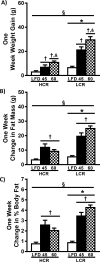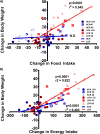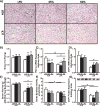Increased aerobic capacity reduces susceptibility to acute high-fat diet-induced weight gain
- PMID: 27465260
- PMCID: PMC5572206
- DOI: 10.1002/oby.21564
Increased aerobic capacity reduces susceptibility to acute high-fat diet-induced weight gain
Abstract
Objective: Aerobic capacity is the most powerful predictor of all-cause mortality in humans; however, its role in the development of obesity and susceptibility for high-fat diet (HFD)-induced weight gain is not completely understood.
Methods: Herein, a rodent model system of divergent intrinsic aerobic capacity [high capacity running (HCR) and low capacity running (LCR)] was utilized to evaluate the role of aerobic fitness on 1-week HFD-induced (45% and 60% kcal) weight gain. Food/energy intake, body composition analysis, and brown adipose tissue gene expression were assessed as important potential factors involved in modulating HFD-induced weight gain.
Results: HCR rats had reduced 1-week weight gain on both HFDs compared with LCR. Reduced HFD-induced weight gain was associated with greater adaptability to decrease food intake following initiation of the HFDs. Further, the HCR rats were observed to have reduced feeding efficiency and greater brown adipose mass and expression of genes involved in thermogenesis.
Conclusions: Rats with high intrinsic aerobic capacity have reduced susceptibility to 1-week HFD-induced weight gain, which is associated with greater food intake adaptability to control intake of energy-dense HFDs, reduced weight gain per kcal consumed, and greater brown adipose tissue mass and thermogenic gene expression.
© 2016 The Obesity Society.
Conflict of interest statement
The authors have no conflicts of interest to disclose for this research.
Figures





Similar articles
-
Intrinsic aerobic capacity impacts susceptibility to acute high-fat diet-induced hepatic steatosis.Am J Physiol Endocrinol Metab. 2014 Aug 15;307(4):E355-64. doi: 10.1152/ajpendo.00093.2014. Epub 2014 Jun 24. Am J Physiol Endocrinol Metab. 2014. PMID: 24961240 Free PMC article.
-
Gut microbiota are linked to increased susceptibility to hepatic steatosis in low-aerobic-capacity rats fed an acute high-fat diet.Am J Physiol Gastrointest Liver Physiol. 2016 Jul 1;311(1):G166-79. doi: 10.1152/ajpgi.00065.2016. Epub 2016 Jun 10. Am J Physiol Gastrointest Liver Physiol. 2016. PMID: 27288420 Free PMC article.
-
Ovariectomized Highly Fit Rats Are Protected against Diet-Induced Insulin Resistance.Med Sci Sports Exerc. 2016 Jul;48(7):1259-69. doi: 10.1249/MSS.0000000000000898. Med Sci Sports Exerc. 2016. PMID: 26885638 Free PMC article.
-
Fat and energy balance.Ann N Y Acad Sci. 1997 Sep 20;827:431-48. doi: 10.1111/j.1749-6632.1997.tb51853.x. Ann N Y Acad Sci. 1997. PMID: 9329773 Review.
-
Effect of high fat diets on energy balance and thermogenesis in brown adipose tissue of lean and genetically obese ob/ob mice.J Nutr. 1987 Dec;117(12):2147-53. doi: 10.1093/jn/117.12.2147. J Nutr. 1987. PMID: 3320290 Review.
Cited by
-
Divergence in aerobic capacity and energy expenditure influence metabolic tissue mitochondrial protein synthesis rates in aged rats.Geroscience. 2024 Apr;46(2):2207-2222. doi: 10.1007/s11357-023-00985-1. Epub 2023 Oct 26. Geroscience. 2024. PMID: 37880490 Free PMC article.
-
Identification of Effective Programs to Improve Access to and Use of Trails among Youth from Under-Resourced Communities: A Review.Int J Environ Res Public Health. 2020 Oct 22;17(21):7707. doi: 10.3390/ijerph17217707. Int J Environ Res Public Health. 2020. PMID: 33105592 Free PMC article. Review.
-
Low-intensity exercise induces acute shifts in liver and skeletal muscle substrate metabolism but not chronic adaptations in tissue oxidative capacity.J Appl Physiol (1985). 2019 Jul 1;127(1):143-156. doi: 10.1152/japplphysiol.00820.2018. Epub 2019 May 16. J Appl Physiol (1985). 2019. PMID: 31095457 Free PMC article.
-
Reduced Liver-Specific PGC1a Increases Susceptibility for Short-Term Diet-Induced Weight Gain in Male Mice.Nutrients. 2021 Jul 28;13(8):2596. doi: 10.3390/nu13082596. Nutrients. 2021. PMID: 34444756 Free PMC article.
-
Rats Selectively Bred for High Voluntary Physical Activity Behavior are Not Protected from the Deleterious Metabolic Effects of a Western Diet When Sedentary.Curr Dev Nutr. 2019 Mar 27;3(6):nzz017. doi: 10.1093/cdn/nzz017. eCollection 2019 Jun. Curr Dev Nutr. 2019. PMID: 31111117 Free PMC article.
References
-
- Flegal KM, Carroll MD, Kit BK, Ogden CL. Prevalence of obesity and trends in the distribution of body mass index among US adults, 1999–2010. JAMA. 2012;307:491–497. - PubMed
-
- Blundell JE, Stubbs RJ, Golding C, Croden F, Alam R, Whybrow S, et al. Resistance and susceptibility to weight gain: individual variability in response to a high-fat diet. Physiol Behav. 2005;86:614–622. - PubMed
-
- Bouchard C, Tremblay A, Despres JP, Nadeau A, Lupien PJ, Theriault G, et al. The response to long-term overfeeding in identical twins. N Engl J Med. 1990;322:1477–1482. - PubMed
-
- Hopkins M, Jeukendrup A, King NA, Blundell JE. The relationship between substrate metabolism, exercise and appetite control: does glycogen availability influence the motivation to eat, energy intake or food choice? Sports medicine. 2011;41:507–521. - PubMed
MeSH terms
Substances
Grants and funding
LinkOut - more resources
Full Text Sources
Other Literature Sources
Medical

